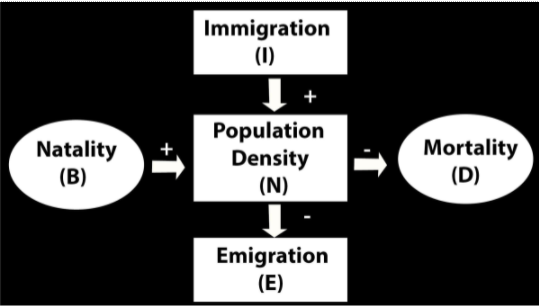
If in a population, natality is balanced by mortality then there will be.
(a) A decrease in population growth
(b) Zero population growth
(c) Increase in population growth
(d) Overpopulation
Answer
578.1k+ views
Hint: Natality refers to the number of births and hence causes an increase in the population while mortality is related to the number of deaths so it results in a decrease in the population. When balanced, their effects are nullified.
Complete answer:
If a population’s natality is balanced by mortality then there will be zero population growth.
Let's begin the explanation by understanding what is population density.
Population size is technically called 'population density.' It is represented by the letter 'N'. Whatever may be the overall reasons, the density of a population in a given habitat, during a given time is not constant. This happens due to changes in four basic processes. Two out of these four processes (natality and immigration) cause an increase in the population density, while the other two processes (mortality and emigration) result in a fall in population density.
Now let’s learn more about the terms natality and mortality.
-The total number of births during a given time in a population that is added to the existing density is called ‘natality.’
-The total number of deaths during a given time in a population is called ‘mortality’.
-The total number of individual species that have come into a habitat from elsewhere during the time under consideration, altogether account for 'immigration.'
-Emigration: The total number of individuals of a population who left the habitat and gone elsewhere during the time under consideration, account for 'emigration.'
Thus, if N is a population density at a time t, then it's the density at time t+1 is
${ N }_{ t+1 }\quad =\quad { N }_{ t }\quad +\quad \left\lceil \left( B+I \right) \quad -\quad \left( D+E \right) \right\rceil$
Here (B+E) are birth and immigrants, and
(D+E) are death and emigrants
You can see from the above equation that if in a population, natality is balanced by mortality then there will be zero population growth.
So, the correct answer is, (b) ‘zero population growth.’
Note: -In a population when natality is less than mortality and immigration is less than emigration, the population growth decreases.
-In a population when natality is more than mortality and immigration is more than emigration the population growth increases.

Complete answer:
If a population’s natality is balanced by mortality then there will be zero population growth.
Let's begin the explanation by understanding what is population density.
Population size is technically called 'population density.' It is represented by the letter 'N'. Whatever may be the overall reasons, the density of a population in a given habitat, during a given time is not constant. This happens due to changes in four basic processes. Two out of these four processes (natality and immigration) cause an increase in the population density, while the other two processes (mortality and emigration) result in a fall in population density.
Now let’s learn more about the terms natality and mortality.
-The total number of births during a given time in a population that is added to the existing density is called ‘natality.’
-The total number of deaths during a given time in a population is called ‘mortality’.
-The total number of individual species that have come into a habitat from elsewhere during the time under consideration, altogether account for 'immigration.'
-Emigration: The total number of individuals of a population who left the habitat and gone elsewhere during the time under consideration, account for 'emigration.'
Thus, if N is a population density at a time t, then it's the density at time t+1 is
${ N }_{ t+1 }\quad =\quad { N }_{ t }\quad +\quad \left\lceil \left( B+I \right) \quad -\quad \left( D+E \right) \right\rceil$
Here (B+E) are birth and immigrants, and
(D+E) are death and emigrants
You can see from the above equation that if in a population, natality is balanced by mortality then there will be zero population growth.
So, the correct answer is, (b) ‘zero population growth.’
Note: -In a population when natality is less than mortality and immigration is less than emigration, the population growth decreases.
-In a population when natality is more than mortality and immigration is more than emigration the population growth increases.

Recently Updated Pages
Master Class 12 Business Studies: Engaging Questions & Answers for Success

Master Class 12 Economics: Engaging Questions & Answers for Success

Master Class 12 English: Engaging Questions & Answers for Success

Master Class 12 Social Science: Engaging Questions & Answers for Success

Master Class 12 Maths: Engaging Questions & Answers for Success

Master Class 12 Chemistry: Engaging Questions & Answers for Success

Trending doubts
What are the major means of transport Explain each class 12 social science CBSE

Which are the Top 10 Largest Countries of the World?

Draw a labelled sketch of the human eye class 12 physics CBSE

Explain sex determination in humans with line diag class 12 biology CBSE

The pH of the pancreatic juice is A 64 B 86 C 120 D class 12 biology CBSE

Explain sex determination in humans with the help of class 12 biology CBSE




